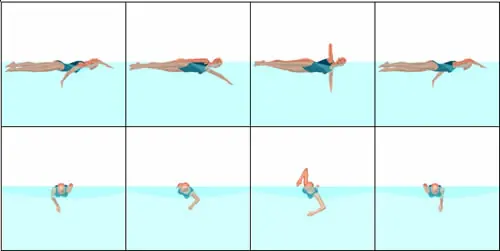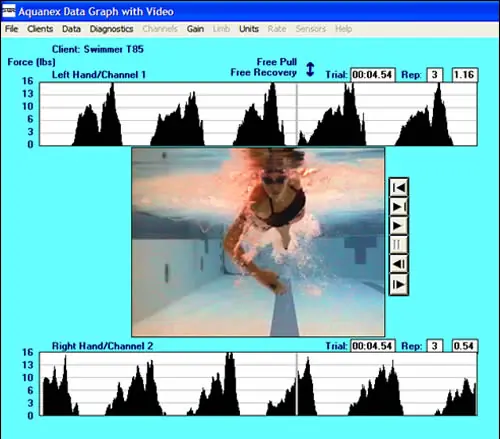Breathing Head Motion
An optimal non-breathing head position forms a bow wave along the side of the head. Then, only minimal head rotation is necessary to breathe in the trough of the bow wave. The head rotates until one eye (goggle) is above the surface and the top of the water is in the visual field (Figure 2).
The head rotation only needs to be enough to bring the mouth above the surface. The eye that is above the surface can sight a point on the wall directly opposite the head. When inhalation is complete, rotation returns the head to the non-breathing position.

Figure 2. Head rotation to the breathing position and return to non-breathing position.
If the head is only rotated to breathe (i.e. the head does not lift or drop), there is no distortion of the body and no increase in the cross-section. As shown in each frame of the biomechanical model of Figure 2 and the swimmer in Figure 3, the legs stay behind the torso to minimize the cross section.
Cues also synchronize head rotation and inhalation with the arm motion (Table 1). While the head is in the non-breathing position, the swimmer exhales through the nose and mouth. As the breathing-side hand passes beneath the head, the swimmer prepares to rotate the head. The head rotates with the push phase of the hand. Exhalation ends as the mouth rises above the surface.
As the arm breaks the surface, inhalation begins. As the arm passes the shoulder on the recovery, inhalation ends and the head rotates to the non-breathing position.
| Head Position/Motion | Visual Cue | Kinesthetic Cue |
| Non-Breathing | See pool wall and bottom | Feel water level just above hairline |
| Rotation to Breathe | See hand pass beneath head | Feel hand push back |
| Breathing | See pool wall directly opposite head | Feel water level at corner of mouth |
| Rotation to Recover | See arm pass shoulder | Feel arm pass shoulder |
Table 1. Visual and kinesthetic cues for the head.

Figure 3. Underwater video and hand force curves for freestyle. The vertical lines on the force curves
are synchronized with the video image. An effective non-breathing head position with the water level
just above the hairline minimizes the body cross-section and makes it possible to breathe with
minimal head rotation.
Practice Repetitions
It takes thousands (and usually tens of thousands) of practice repetitions to develop permanency in a technique change. Slow, short swims of non-breathing strokes allow the swimmer to constantly focus on the cues and maintain an optimal head position (Havriluk, 2006).
An effective drill is to alternate one or two non-breathing stroke cycles with a breathing cycle. This provides continued practice on the non-breathing position with opportunity to work on the breathing motion.
Conclusion
An effective freestyle breathing motion requires first establishing an effective non-breathing head position. An optimal non-breathing head position minimizes the head rotation necessary to breathe.
Visual and kinesthetic cues are critical for checking the non-breathing head position and controlling the breathing motion. An improvement in breathing minimizes the body cross-section throughout the stroke cycle, decreases resistance, and makes any swim less fatiguing. Not only will your swim be more enjoyable, but faster.


